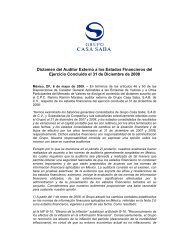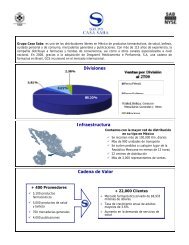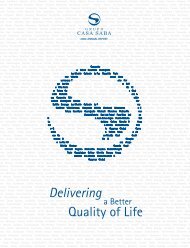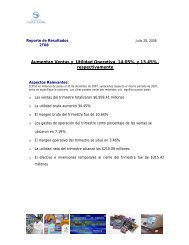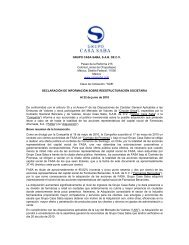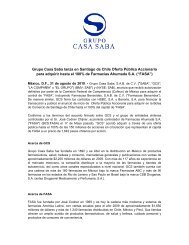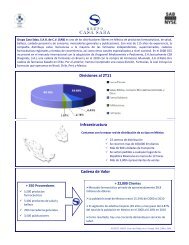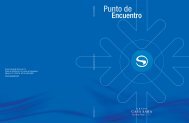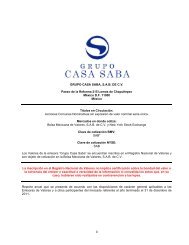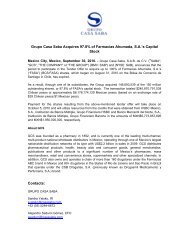Table of Contents ii) Change in the tax consolidation regime which required for <strong>de</strong>termining at December 31, <strong>20</strong>09 annual income tax as if tax consolidation rules had not existed since 1999 and henceforth. Therefore, the restated income tax that is related to the benefits of tax consolidation obtained as of that year, is paid for: (a) operating tax losses and losses on sale of stock used in tax consolidation that would have not been carried forward individually by the entity that incurred them; (b) special consolidation items for transactions among entities of the Group; and (c) divi<strong>de</strong>nds paid among entities of the Group that are paid out of earnings not taxed for income tax purposes in the past. As a result of tax <strong>de</strong>consolidation and the resulting payments of income taxes discussed in the paragraph a) in this same Note, the reversal process of tax benefits generated up to December 31, <strong>20</strong>09 referred in the paragraph above is no longer applicable to the Group. Effective <strong>20</strong>11, the Company again adopted the tax consolidation regime; therefore, the benefits generated in tax consolidation will be reversed by consi<strong>de</strong>ring the terms and percentages set forth in the Income Tax Law. 19. Operating segments: Effective January 1, <strong>20</strong>11, the Group adopted Mexican FRS B-5, “Financial information by segment” (FRS B-5), which superse<strong>de</strong>d Bulletin B-5 with the same name. That adoption had no impact on the consolidated financial statements. Operating segments are the components of an entity oriented toward production and sale of goods, as well as ren<strong>de</strong>ring services. The Group operates on a regional basis by consi<strong>de</strong>ring the distribution segment and retail pharmacy segment. Each regional director supervises and is responsible for all the business activities in each unit. These activities refer to the distribution of pharmaceutical products, as well as health and beauty aids/other products, entertainment products, food/non-perishable products through its operating subsidiaries. The Group distributes these product lines through its distribution network, as well as retail pharmacies throughout Mexico, as well as Rio <strong>de</strong> Janeiro, Brasil and, effective <strong>20</strong>10, Chile and Peru. The regional director, who is one level below the chief financial officer and chief executive officer in the organizational structure, reports to such officers the operating results of the business unit. The Group’s management internally evaluates the results and performance of each business unit for <strong>de</strong>cision-making purposes. The main indicator used by Group’s management to evaluate the performance of each entity is operating EBITDA, which the Group <strong>de</strong>fines as operating income plus <strong>de</strong>preciation and amortization. This indicator, which is presented in the selected financial information, is consistent with the information used by Group’s management for <strong>de</strong>cision-making purposes. The accounting policies applied to <strong>de</strong>termine the financial information by operating segment are consistent with those <strong>de</strong>scribed in Note 3). F-48
Table of Contents All significant transactions between related parties have been eliminated in the preparation of the information by operating segments. At December 31, <strong>20</strong>11, <strong>20</strong>10 and <strong>20</strong>09 the information was as follows: <strong>20</strong>11 <strong>20</strong>10 <strong>20</strong>09 Item Retail pharmacies Distribution business Total Retail pharmacies Business distribution Total Retail pharmacies Distribution business Total Net sales Ps. 24,058,753 22,509,473 46,568,226 8,586,462 25,657,7<strong>20</strong> 34,244,182 3,224,313 26,567,344 29,791,657 Operating income 426,961 1,139,506 1,566,467 126,147 558,451 684,598 360,747 529,978 890,725 Depreciation and amortization 378,052 61,688 439,740 114,639 76,366 191,005 34,675 73,984 108,659 EBITDA 805,012 363,705 1,168,717 240,786 634,817 875,603 395,422 603,962 999,384 At December 31, <strong>20</strong>11, and <strong>20</strong>10, the selected information of balance sheet by eliminating intercompany balances was as follows: <strong>20</strong>11 <strong>20</strong>10 Retailer pharmacies Business distribution Total Retailer pharmacies Business distribution Total Current assets Ps. 6,212,516 13,277,579 19,490,095 5,954,685 12,739,508 18,694,193 Noncurrent assets 5,984,315 6,486,653 12,470,968 6,176,706 6,441,812 12,618,518 Total liabilities 10,222,881 14,691,503 24,914,384 9,770,292 14,459,571 24,229,861 <strong>20</strong>. Contingencies and commitments: a) On February 12, <strong>20</strong>07, the Group filed appeals for constitutional relief with the Fe<strong>de</strong>ral Tax Court against the tax reform that binds taxpayers to <strong>de</strong>termine asset tax by applying the 1.25 percent annual rate to the average value of assets and not to reduce the value of <strong>de</strong>bts contracted from the taxable base, effective January 1, <strong>20</strong>07. In September <strong>20</strong>11, the Fe<strong>de</strong>ral Tax Court han<strong>de</strong>d down a favorable ruling in favor of the Group. b) On March 28, <strong>20</strong>08, the Mexican tax authorities issued an “invitation” to the Company to file an amen<strong>de</strong>d tax return of consolidated income tax for fiscal year <strong>20</strong>05 and prove that it ad<strong>de</strong>d the amount of certain prior year tax losses to consolidated taxable income for the same year. Previously, those tax losses had been reduced by the Group to <strong>de</strong>termine cumulative inventory, in accordance with the Income Tax Law. In May <strong>20</strong>08 and March <strong>20</strong>09, Management filed the amen<strong>de</strong>d income tax return that met with that invitation. Accordingly, there is no contingency payable by the Company. However, Management would carry out actions that would imply adoption of a criterion other than that of the tax authorities, which could have this matter solved in the Fe<strong>de</strong>ral Tax Court. In Management’s opinion, the Company is not bound to comply with the criterion set forth by the tax authorities as the Group has reasonable arguments to sustain its interpretation. In September <strong>20</strong>09, the Company filed a claim for a refund of the consolidated income tax payment improperly ma<strong>de</strong> in the amount of Ps. 149,294, due to the invitation abovementioned. On November 12, <strong>20</strong>09, the tax authorities ma<strong>de</strong> a partial refund in the amount of Ps. 26,4<strong>20</strong>. Subsequently, the tax authority rejected to refund the remaining amount. In February <strong>20</strong>10, Management filed an appeal for annulment against that resolution. Management estimates that there are reasonable elements for obtaining a result favorable to the Company’s interests. F-49
- Page 1 and 2:
UNITED STATES SECURITIES AND EXCHAN
- Page 3 and 4:
TABLE OF CONTENTS PART I Item 1. Id
- Page 5 and 6:
Table of Contents We caution you th
- Page 7 and 8:
Table of Contents Year ended Decemb
- Page 9 and 10:
Table of Contents To the extent tha
- Page 11 and 12:
Table of Contents We Provide Remote
- Page 13 and 14:
Table of Contents We Are a Holding
- Page 15 and 16:
Table of Contents Today, the market
- Page 17 and 18:
Table of Contents Any future deprec
- Page 19 and 20:
Table of Contents Risk Factors Rela
- Page 21 and 22:
Table of Contents In August 2009, A
- Page 23 and 24:
Table of Contents In April of 2008,
- Page 25 and 26:
Table of Contents The Acquisition h
- Page 27 and 28:
Table of Contents On September 19,
- Page 29 and 30:
Table of Contents On September 19,
- Page 31 and 32:
Table of Contents At our annual gen
- Page 33 and 34:
Table of Contents We distribute the
- Page 35 and 36:
Table of Contents In our stores, we
- Page 37 and 38:
Table of Contents Prior to 2008, th
- Page 39 and 40:
Table of Contents In 2011, we conti
- Page 41 and 42:
Table of Contents To better serve s
- Page 43 and 44:
Table of Contents ● Mexsana talcu
- Page 45 and 46:
Table of Contents Payments and Coll
- Page 47 and 48:
Table of Contents Information Techn
- Page 49 and 50:
Table of Contents In addition to th
- Page 51 and 52:
Table of Contents (3) In Mexico, ph
- Page 53 and 54:
Table of Contents (4) To calculate
- Page 55 and 56:
Table of Contents We also offer our
- Page 57 and 58:
Table of Contents The devaluation o
- Page 59 and 60:
Table of Contents (****) Associates
- Page 61 and 62:
Table of Contents In January 2009 w
- Page 63 and 64:
Table of Contents In our Retail Pha
- Page 65 and 66:
Table of Contents Inflation and Int
- Page 67 and 68:
Table of Contents With the acquisit
- Page 69 and 70:
Table of Contents Results of Operat
- Page 71 and 72:
Table of Contents Net Income. The G
- Page 73 and 74:
Table of Contents On March 25, 2010
- Page 75 and 76:
Table of Contents Grupo Casa Saba i
- Page 77 and 78:
Table of Contents In the event that
- Page 79 and 80:
Table of Contents Grupo Casa Saba h
- Page 81 and 82:
Table of Contents Prior to the noti
- Page 83 and 84:
Property and equipment Our balance
- Page 85 and 86:
Labor obligations Our labor liabili
- Page 87 and 88:
Tax and legal contingencies We are
- Page 89 and 90:
FRS C-4. “Inventories” (FRS C-4
- Page 91 and 92:
Table of Contents As of the transit
- Page 93 and 94:
Table of Contents Name and Date of
- Page 95 and 96:
Table of Contents Employee Profit S
- Page 97 and 98:
Table of Contents The Chairman of t
- Page 99 and 100:
Table of Contents All related party
- Page 101 and 102:
Table of Contents Significant Chang
- Page 103 and 104:
Table of Contents The table below s
- Page 105 and 106:
Table of Contents ● ● ● ● a
- Page 107 and 108:
Table of Contents ● ● ● ●
- Page 109 and 110:
Table of Contents Directors Under t
- Page 111 and 112:
Table of Contents Forfeiture of Sha
- Page 113 and 114:
Table of Contents We are organized
- Page 115 and 116:
Table of Contents Ownership by non-
- Page 117 and 118:
Table of Contents ● Gain on sales
- Page 119 and 120:
Table of Contents We anticipate tha
- Page 121 and 122:
Table of Contents As a foreign priv
- Page 123 and 124:
Table of Contents Item 12. Item 12A
- Page 125 and 126:
Table of Contents During the review
- Page 127 and 128: Table of Contents Since we are Mexi
- Page 129 and 130: Table of Contents PART III Item 17.
- Page 131 and 132: Table of Contents INDEX TO CONSOLID
- Page 133 and 134: Table of Contents REPORT OF INDEPEN
- Page 135 and 136: Table of Contents ATTESTATION REPOR
- Page 137 and 138: Table of Contents Grupo Casa Saba,
- Page 139 and 140: Table of Contents Grupo Casa Saba,
- Page 141 and 142: Table of Contents NOTES TO THE CONS
- Page 143 and 144: Table of Contents a) Through an ass
- Page 145 and 146: Table of Contents Proforma condense
- Page 147 and 148: Table of Contents 3. Significant ac
- Page 149 and 150: Table of Contents The errors accoun
- Page 151 and 152: Table of Contents Investments in as
- Page 153 and 154: Table of Contents Effective 2011, t
- Page 155 and 156: Table of Contents The Company recog
- Page 157 and 158: Table of Contents The Group has cre
- Page 159 and 160: Table of Contents In addition, the
- Page 161 and 162: Table of Contents Foreign currency
- Page 163 and 164: Table of Contents 8. Derivative fin
- Page 165 and 166: Table of Contents 10. Goodwill, int
- Page 167 and 168: Table of Contents At December 31, 2
- Page 169 and 170: Table of Contents On January 25 and
- Page 171 and 172: Table of Contents 13. Other payable
- Page 173 and 174: Table of Contents 15. Foreign curre
- Page 175 and 176: Table of Contents On December 18, 2
- Page 177: Table of Contents c) Tax loss carry
- Page 181 and 182: Table of Contents On December 7, 20
- Page 183 and 184: Table of Contents ● ● For real
- Page 185 and 186: Table of Contents 22. Differences b
- Page 187 and 188: Table of Contents ii) For Mexican F
- Page 189 and 190: Table of Contents At December 31, 2
- Page 191 and 192: Table of Contents 23. Reconciliatio
- Page 193 and 194: Table of Contents 24. Supplementary
- Page 195 and 196: Table of Contents g) Quantitative a
- Page 197 and 198: Table of Contents ● In October 20
- Page 199 and 200: Table of Contents Page Representati
- Page 201 and 202: CREDIT AGREEMENT (THIS “AGREEMENT
- Page 203 and 204: (k) To the best of its knowledge, F
- Page 205 and 206: (aa) Any and all funds used by it t
- Page 207 and 208: “Authorized Officer” shall mean
- Page 209 and 210: “Drawdown” shall mean each draw
- Page 211 and 212: “Interest Payment Date” has the
- Page 213 and 214: “Share Pledge Agreement” shall
- Page 215 and 216: (g) The Lenders shall credit the am
- Page 217 and 218: (e) If the Borrower defaults with a
- Page 219 and 220: (iii) concurrently with the deliver
- Page 221 and 222: (j) Maintenance of Property. The Bo
- Page 223 and 224: (ii) To the extent permitted by the
- Page 225 and 226: (ii) date thereof; Liens imposed by
- Page 227 and 228: ARTICLE THIRTEEN. Conditions Preced
- Page 229 and 230:
(xxii) neither the execution of the
- Page 231 and 232:
(i) Insolvency. (i) If the Borrower
- Page 233 and 234:
(b) If as a result of the amendment
- Page 235 and 236:
(B) The Chilean Collateral Agent. (
- Page 237 and 238:
(iii) Neither the Chilean Collatera
- Page 239 and 240:
(h) Effective Term. Unless revoked
- Page 241 and 242:
(c) effective. Absent written notic
- Page 243 and 244:
This Credit Agreement is executed i
- Page 245 and 246:
The Chilean Collateral Agent: HSBC
- Page 247 and 248:
(c) If the Central Bank of Mexico s
- Page 249 and 250:
Joint and Several Obligations. (a)
- Page 251 and 252:
(k) Material Adverse Effect. If the
- Page 253 and 254:
Exhibit 4.3 SUMMARY OF THE IRREVOCA
- Page 255 and 256:
(6) defend, at its own cost and exp
- Page 257 and 258:
(5) the balance remaining after the
- Page 259 and 260:
In addition, articles Three, Four a
- Page 261 and 262:
(j) deliver, within five (5) days f
- Page 263 and 264:
Governing Law and Jurisdiction. Thi
- Page 265 and 266:
Servicios Corporativos Doctorgen, S
- Page 267 and 268:
Exhibit 12.2 CERTIFICATION I, Juan



